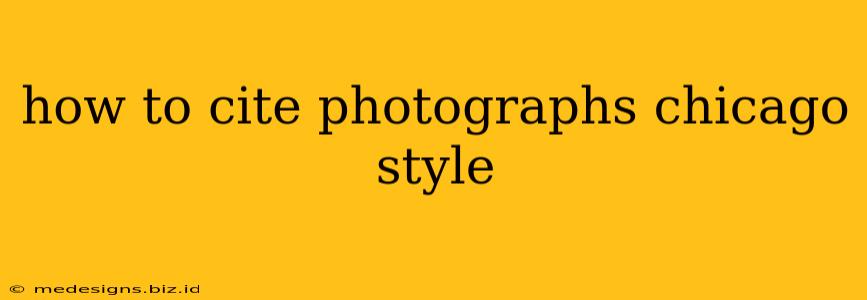Photograph citations in Chicago style might seem daunting at first, but with a clear understanding of the style guide's rules, you can accurately and efficiently cite all your visual sources. This guide will walk you through the intricacies of citing photographs in both notes-bibliography and author-date styles, offering practical examples to solidify your understanding. We'll cover various scenarios, from citing individual photographs to collections and online images.
Understanding Chicago's Citation Requirements for Photographs
The core principle remains consistent across both Chicago styles: provide enough information for a reader to locate the photograph. This includes identifying the photographer (if known), the title of the photograph (if any), the date of creation (if known), and the location where the photograph is found.
Key Elements of a Photograph Citation:
- Photographer's Name: If known, this is listed first, inverted (Last Name, First Name).
- Title of Photograph: If available, enclose the title in quotation marks. If no title is available, you can use a descriptive title in brackets [ ].
- Date of Creation: Use the year, or year and month if known (e.g., 1925, or May 1925).
- Repository Information: This specifies where the photograph can be found (e.g., museum, archive, website). Include the location (city and state/country) and the identifying number or call number (if available).
- URL (For Online Photographs): Always include the full URL if the image is accessed online.
- Date of Access: For online sources, always include the date you accessed the image (Day Month Year).
Chicago Style Citation Examples: Notes-Bibliography Style
This style uses footnotes or endnotes and a bibliography. Here are several examples showcasing different scenarios:
Example 1: Print Photograph in a Book
Footnote:
- Margaret Bourke-White, Gandhi at Prayer, 1946, from Half a Century of Photography, New York, NY: The Museum of Modern Art, 1999, 122.
Bibliography Entry:
Bourke-White, Margaret. Gandhi at Prayer. 1946. In Half a Century of Photography, 122. New York, NY: The Museum of Modern Art, 1999.
Example 2: Online Photograph
Footnote:
- "View of the Eiffel Tower," Library of Congress, accessed June 26, 2024, https://www.loc.gov/item/2016656062/.
Bibliography Entry:
"View of the Eiffel Tower." Library of Congress. Accessed June 26, 2024. https://www.loc.gov/item/2016656062/
Example 3: Photograph from an Archive (with Accession Number)
Footnote:
- [Photograph of unidentified family], c. 1910, Smithsonian National Museum of American History, Accession No. 1234567.
Bibliography Entry:
[Photograph of unidentified family]. c. 1910. Smithsonian National Museum of American History, Accession No. 1234567. Washington, D.C.
Chicago Style Citation Examples: Author-Date Style
In the author-date system, citations are shorter, appearing directly in the text and followed by a complete reference list at the end.
Example 1: Online Photograph
(In-text citation): ("View of the Eiffel Tower" 2024)
References Entry:
"View of the Eiffel Tower." Library of Congress. Accessed June 26, 2024. https://www.loc.gov/item/2016656062/
Example 2: Print Photograph in a Book
(In-text citation): (Bourke-White 1999, 122)
References Entry:
Bourke-White, Margaret. Gandhi at Prayer. 1946. In Half a Century of Photography, 122. New York, NY: The Museum of Modern Art, 1999.
Handling Unclear Information
If you lack specific information, such as the photographer's name or the exact date, use "Unknown" or an approximation (e.g., "c. 1900"). Always strive for accuracy; if unsure, consult with a librarian or research specialist.
Conclusion
Mastering Chicago style photograph citations requires attention to detail. By consistently providing the necessary information—photographer, title, date, and location—you can ensure that your work adheres to academic standards and provides readers with a clear path to verify your sources. Remember to consult the most recent edition of The Chicago Manual of Style for the most up-to-date guidelines.
